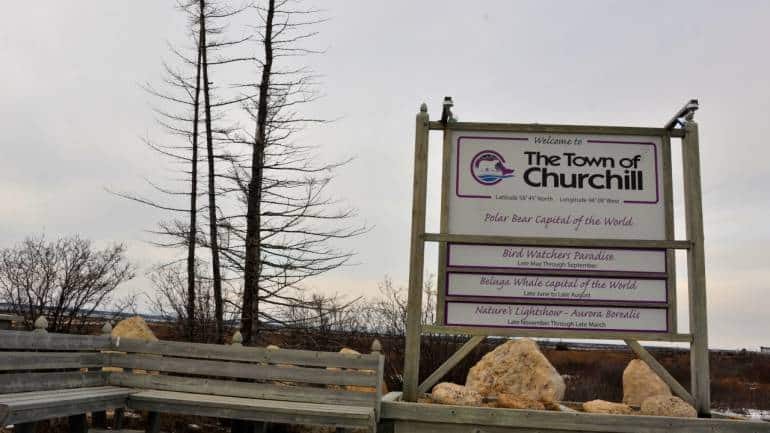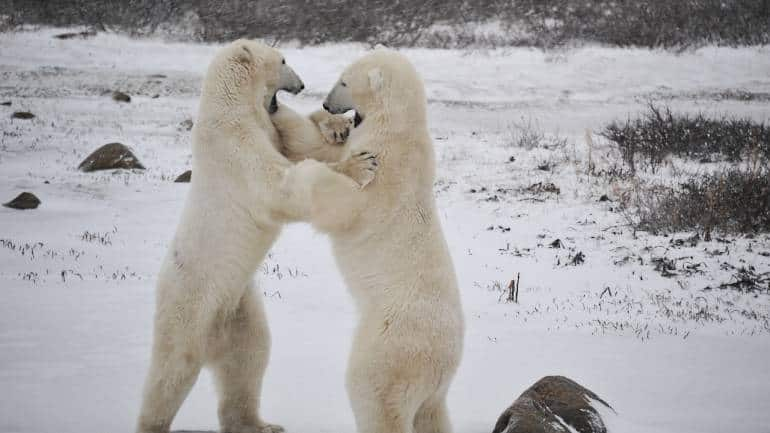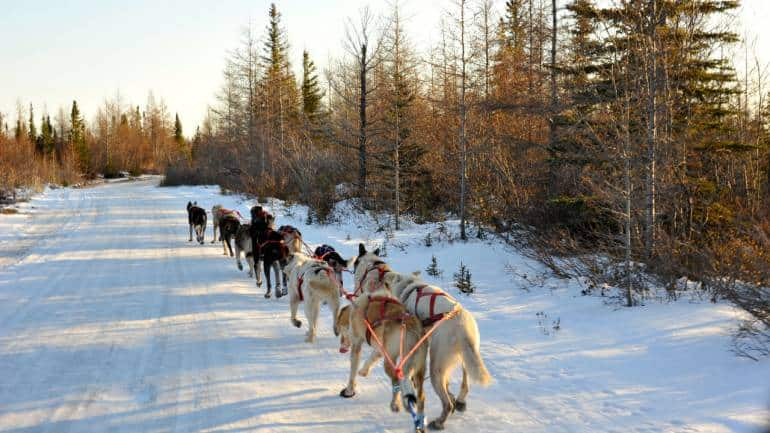



It might sound strange, but one bitterly cold day in Churchill (Manitoba, Canada), I wanted to break open the prison door and hug an inmate. A big, burly, white prisoner who had strayed into the town, rummaging dumpsters and scaring the neighbourhood.
There’s no road that leads to Churchill. I had wriggled into thermal wear, snow boots and thick mittens, and get into a charter flight to reach this prison. It was nearly -20 degrees Celsius; the wind was howling, and I was cold to the bone, but my heart was racing with excitement.
Sadly, the gates of the prison were locked. No one is allowed to meet the inmates.
***
In Churchill, the Polar Bear Capital of the World, it would be barmy to hug a polar bear, the largest carnivorous land mammal on Earth - nearly 450 kilograms in weight and 11 ft tall on its hindlegs. That prison that I wanted to break open is a Holding Facility for rogue polar bears that swagger into the town looking for food. Thus began my Polar Bear Expedition in Churchill, often called the best place in the world to see polar bears in their natural habitat.
 (Photo by Preeti Verma Lal)
(Photo by Preeti Verma Lal)
That disappointment ended as soon as I hopped into a 240 horsepower Tundra Buggy to drive to where the bears lived: Polar Bear Point, a neighbourhood of nearly 900 polar bears who walk inland in early winter waiting for the Hudson Bay to freeze and for the seals – their favourite lunch – to pop their heads out of the breathing holes.
Polar Bear Point is also the home of Miss Piggy - a crash-landed C46 aircraft (she once carried a cargo of pigs, hence the name) that has been lazing on a rocky cliff in Churchill since 1979.
***
The drive into the wilderness was bumpy. It was so barren. No human. No vegetation around. Just miles and miles of snow and ice floe on lakes.
I could hear the scratchy zuk zeeek zeeek call of the white-tailed ptarmigan. The white fox with prized fur was here too. And the snowy owl, camouflaged against the white of the landscape. And the four white bogies of the Tundra Buggy Lodge where I was to bunk for the next three nights.
The cellphone had died. There was no contact with the outside world. All I had was a square window by the bunk to peep at the faraway Hudson Bay, which, for centuries, has been the favourite haunt of the polar bears.
***
The next morning, I was up before the sun. There were hot pancakes and maple syrup for breakfast. I had to leave at 8 am for the day’s excursion, but getting ready was a tedious task. Many layers of snug, thermal clothing were needed to keep the cold out.
The engine of the Buggy was being revved up and the expedition leader was stacking soup bowls, cookies, tootsie rolls, hot chocolate, shredded tuna, artichoke dip for the day out in the wild in search of polar bears.
Despite the layers, the chill was treacherous. I stood by the propane heater looking out of the window for polar bears.
Minutes and miles went by but there was no bear.
Suddenly, I heard a whisper, and a rustle, as if someone were stomping on dried leaves.
A few meters away, two 800-pound polar bears were sparring, playing in the snow, shaking the snowflakes off their fur, grunting with pride, oblivious of the world – and the people – around them. I could not believe that these 11-ft tall bears can jump 6 feet and run at 25 km per hour. I stood staring, and forgot to blink.
 Polar bears sparring, playing, grunting in Churchill, Manitoba, Canada. (Photo by Preeti Verma Lal)***
Polar bears sparring, playing, grunting in Churchill, Manitoba, Canada. (Photo by Preeti Verma Lal)***
The itinerary was repetitive. Every morning, I wriggled into Arctic gear. The expedition leader stacked lunch, and the driver meandered through the dirt track. And the bears? They were always there. One day, a fat bear walked up to the Buggy. The bear was so close, it could have munched me for lunch.
For three days, I did not touch land. I warmed tortillas over the Buggy’s propane heater. I survived without the cell phone. But I watched the polar bears sparring, playing, nudging, grunting, plodding on mounds of snow.
When it was time to leave the Tundra Buggy Lodge at Polar Bear Point, I got adventurous. It took a little coaxing, but the driver reluctantly agreed to let me drive the 25-tonne gigantic Tundra Buggy.
Hesitantly, I steered the wheel on the snow sheets. What if it skidded? What if… Nothing untoward happened. The Buggy with monster tyres did not turn turtle. Faraway, I watched a polar bear amble towards the shore. The good fella could have hitched a ride with me. He did not!
 You can also go dog sledding in Churchill. (Photo by Preeti Verma Lal)
You can also go dog sledding in Churchill. (Photo by Preeti Verma Lal)
Where the polar bears are
- It is estimated that currently there are 22,000-31,000 polar bears worldwide, of which 60-80% are in Canada.
- Because they spend most of their lives on the sea ice of the Arctic Ocean, depending on the ocean for their food and habitat, polar bears are the only bear species to be considered marine mammals.
- Polar bear fur is translucent, and only appears white because it reflects visible light. Beneath all that thick fur, their skin is jet black.
- Reaching speeds of up to 6m per hour in the water, polar bears can swim for long distances and steadily for many hours to get from one piece of ice to another.
- As recently as 2006, genetic testing confirmed the existence of polar bear-grizzly bear hybrids, also known as ‘grolar bears’ or ‘pizzly bears’.
- Male polar bears can weigh up to 800kg, can measure up to 3 metres long and are twice the size of females. This makes polar bears the largest land carnivore in the world.
- Polar bears have a very strong sense of smell, and can smell their prey from up to a kilometre away.
(Source: World Wildlife Fund)
Discover the latest Business News, Sensex, and Nifty updates. Obtain Personal Finance insights, tax queries, and expert opinions on Moneycontrol or download the Moneycontrol App to stay updated!
Find the best of Al News in one place, specially curated for you every weekend.
Stay on top of the latest tech trends and biggest startup news.